How do you plan the perfect Mount Rainier National Park itinerary?
The answer to this question depends on how much time you have to spend in the park and how much you like to go hiking.
At a minimum, you need two days in the park, in order to visit the highlights and hike a few trails. With a third day, you can explore a quiet corner of the park for a highly underrated experience. And if you are an avid hiker, or if you like to travel at a slower pace, it would be easy to spend a week here and never run out of things to do.
In this post, get an overview on the best things to do in the park, when to visit, and learn how to plan your Mount Rainier itinerary, based on your interests and available time.
IMPORTANT: There are numerous road closures and construction projects planned for 2025, which will impact travel through the park and what is open to visit. A portion of SR 123 will be under construction, potentially causing travel delays. Mowich Lake Road is closed until further notice due to the SR165 Carbon River Fairfax Bridge closure. Ohanapecosh Campground is also closed, which will affect those who want to hike the Silver Falls Loop. Get the full details on the National Park Service website.
Overview of Mount Rainier National Park
Mount Rainier is a glacier-capped, active volcano that can be seen from hundreds of miles away. At 14,411 feet (4,392 meters), Mount Rainier is the tallest mountain in Washington state and the Cascade Range.
With its forests of evergreen trees, subalpine lakes, and network of hiking trails, this is an outdoor paradise for many travelers.
Mount Rainier is located centrally within the national park. Due to its massive size, snow fields, and forested lower slopes, no roads cut across the center of the park. To visit Mount Rainier National Park, you will drive the roads that circumnavigate around the mountain and take the short access roads to get closer to Mount Rainier.
The geography of this national park, plus its large size, makes it impossible to zip through the park in just a day or two. Mount Rainier is a beautiful park to explore, whether or not you are a hiker, which is why I recommend spending a minimum of three days here.

Best Time to Visit Mount Rainier National Park
The summer and early fall is the best time to visit Mount Rainier National Park. This is when all of the roads will be open and many hiking trails will be free of snow. During the summer months, the weather is also the warmest and driest of the year.
The wildflowers typically bloom from mid-July through mid-August. If you want to see Mount Rainier during the peak blooming season, plan your visit for early August.
In the spring and fall, the weather is damp and chilly. During the winter months, massive amounts of snow can fall in the park. It is not unusual for Paradise to get over 50 feet of snow each winter.
During the winter months, you can visit Paradise and go snow shoeing, sledding, skiing, and snowboarding. Snowmobiling is permitted in the southwest corner of the park.
In early fall, several main roads close in the park and don’t reopen to mid to late-spring, cutting off access to some of the best places to visit in Mount Rainier.
Road Closures in Mount Rainier National Park
Here are the opening and closing dates for the roads in the park:
- Stevens Canyon Road: open during the summer and early fall
- Sunrise Road: opens in late June or early July and closes in late September or early October
- Chinook Pass and Cayuse Pass: Chinook Pass and Cayuse Pass are generally open from Memorial Day through mid-November, depending on snowfall
For updates on road status, visit the National Park Service website.

Bench Lake
Best Things to Do in Mount Rainier National Park
Here is a list of the top things to do in Mount Rainier National Park. For more information, and many more photos, check out our guide to the Best Things to Do in Mount Rainier National Park ↓
14 Amazing Things to Do in Mount Rainier National Park
Best things to do in Mount Rainier, from epic hikes to scenic drives and gorgeous viewpoints.1. Visit Paradise. Paradise is one of the most beautiful areas of Mount Rainier National Park. Take your pick from numerous hiking trails that lead higher onto Mount Rainier. The shorter, easier trails take you up to nice viewpoints of the mountain, and these include the Alta Vista Trail (1.7 miles) and the Nisqually Vista Trail (1.2 miles).
2. Hike the Skyline Trail. Located in Paradise, this is one of the best hikes in Mount Rainier National Park. It’s a tough 6 mile hike but the views from Panorama Point are jaw-dropping.
3. See Myrtle Falls. Myrtle Falls is also located in Paradise. It’s a short stroll to one of the prettiest waterfalls in the park (and more great views of Mount Rainier).

Myrtle Falls
4. Visit Reflection Lake. This colorful lake is located near Paradise. From here you have a great view of Mount Rainier and it’s a great spot for a family photo.
5. Go hiking in Sunrise. Like Paradise, Sunrise is one of the best places to spend your time in Mount Rainier National Park. There are a handful of hikes that start in Sunrise, ranging from short, easy strolls to challenging day hikes.
6. Walk the Grove of the Patriarchs Trail. This easy, 1.5-mile walking trail takes you past some of the largest and oldest trees in Mount Rainier National Park.
7. Scenic Drives and Overlooks. Drive the Cayuse Pass and Chinook Pass for stunning views of Mount Rainier. As you drive through the park, there are also numerous overlooks to visit. Our favorites are Sunrise Point and Ricksecker Point.
8. Go Hiking. One of the best ways to experience Mount Rainier National Park is from a hiking trail, of which there are many. Read our article 15 Epic Hikes in Mount Rainier to learn more.
9. Ride the Mount Rainier Gondola. For one of the best views of Mount Rainier, ride the Mount Rainier Gondola to Crystal Mountain. As you have lunch or dinner at Summit House Restaurant, enjoy the spectacular view.
10. Wonderland Trail. The Wonderland Trail is a 93-mile trail that circumnavigates around Mount Rainier. On average, it takes between 9 and 13 days to hike the entire loop.
11. Summit Mount Rainier. It takes most people 2 to 3 days to summit Mount Rainier. You will need a climbing permit and you should have experience mountaineering and hiking glaciated peaks before doing this climb.

Overlooking Paradise from Panorama Point on the Skyline Trail.
How Many Days Do You Need in Mount Rainier?
I recommend spending at least three days in Mount Rainier National Park (one day for Sunrise, one day for Paradise, and one day to either explore the Carbon River area of the park or spend more time on the hiking trails). Extra days give you more time for hiking, for exploring quiet corners of the park, and some contingency time just in case you get bad weather.
We spent six days here and still could have used more time. The hikes are incredible and there are a lot to choose from.
Please practice the seven principles of Leave No Trace: plan ahead, stay on the trail, pack out what you bring to the hiking trail, leave areas as you found them, minimize campfire impacts, be considerate of other hikers, and do not approach or feed wildlife.
Mount Rainier Timed Entry Reservations
In order to enter the Sunrise corridor, a timed entrance permit is necessary during peak season.
Here are the dates for 2025:
- July 11 to September 1 from 7 am to 5 pm
- Weekends and holidays from September 2 to mid-October
Cost: $2; this is in addition to the park entrance fee
Make your reservation: recreation.gov
Here is the reservation schedule:
- For a visit from July 11 through July 31, 2025, tickets are released Friday, May 16 at 8 am Pacific Time
- For a visit from August 1 through September 1, 2025, tickets are released Friday, June 6 at 8 am Pacific Time
- For weekends and holidays from September 2 to the end of the season (mid-October), reservations will be available starting 7 pm the day before only.
The remainder of the permits become available at 7 pm PT the day before the arrival date, starting July 1. So, a permit for July 5 becomes available at 7 pm PT on July 4.
Reservations are valid for a 2-hour entry time (you will have to enter the park some time during this 2-hour window, which you will choose when you make your reservation). If you will be in the park or visit a corridor multiple days, you will need a permit for each day.
You can enter the Sunrise corridor of Mount Rainier National Park before 7 am and after 5 pm without a reservation.
If you are staying in lodging in the park, you do not need a permit for that section of the park (for example, if you are staying at Paradise Inn, you do not need a permit for the Paradise corridor, but you will need a permit for the Sunrise corridor).
I recommend reading the FAQ section on the NPS website because it is packed with information about the permit.
IMPORTANT: The timed entry permit for the Paradise Corridor in 2025 is paused due to a construction project in that part of the park. There is a chance this could resume in 2026.
Mount Rainier National Park Itinerary
First, I list a sample 2 day itinerary which gives you a nice overview of Mount Rainier National Park. This itinerary includes the highlights (Sunrise, Paradise, and Ohanapecosh).
Note: This was originally written as a 3-day itinerary. With the Mowich Road closure, the Carbon River area of the park is not open (that was day 3 of the itinerary).
Following the 2 day Mount Rainier National Park itinerary, I give you suggestions on how to add more time, and the exact 6 day itinerary from our visit.
These itineraries work best from July through mid-October, when the roads are open and the weather is warm.
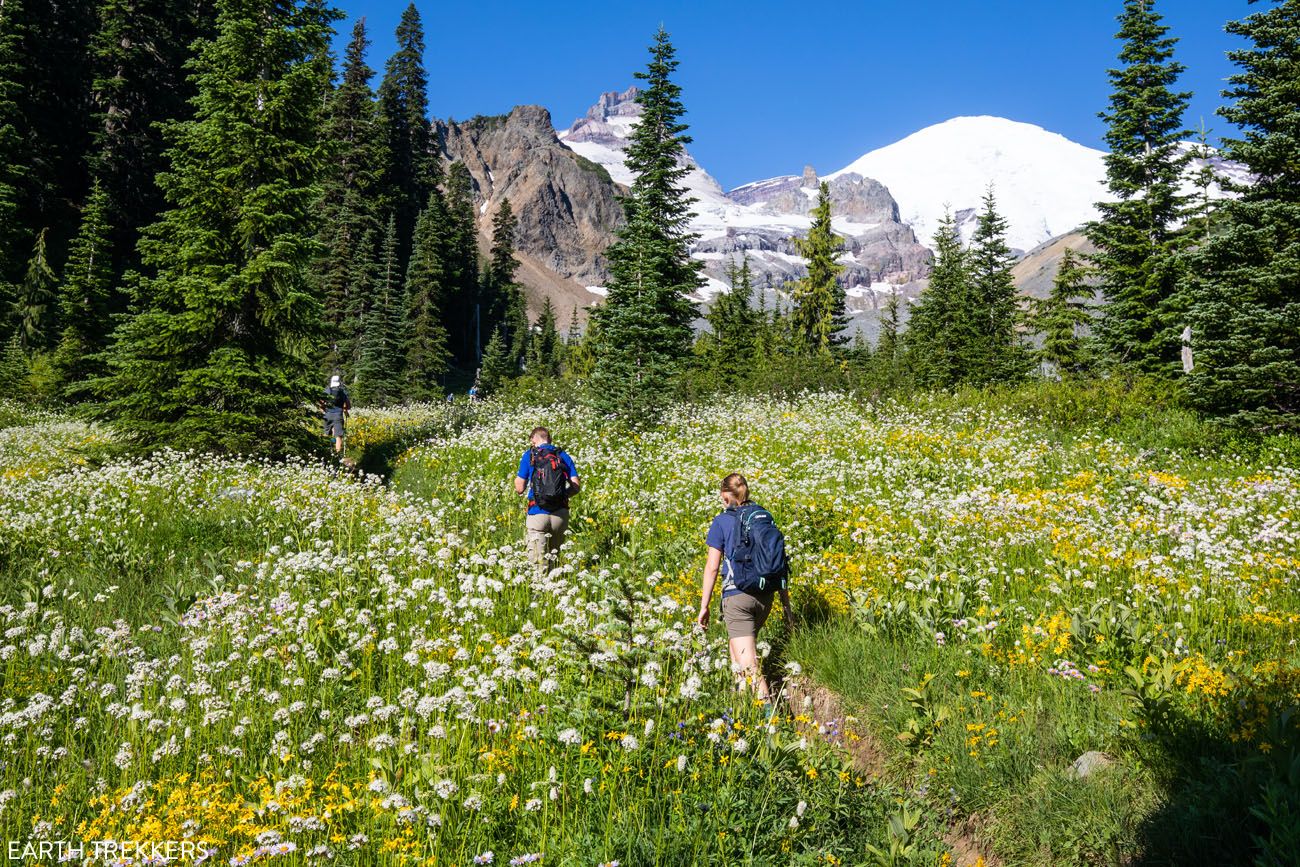
Wildflowers on the trail to Summerland
2 Day Mount Rainier National Park Itinerary
This 2-day itinerary is a good place to start when planning your trip. It is easy to add on to this, if you have more time.
This itinerary starts in Packwood, which is located near the southeastern corner of Mount Rainier National Park. Packwood makes a great home base for exploring the Sunrise and Paradise corridors of the park. You can also spend the first night in Ashford or at the Paradise Inn, but you will spend a lot more time on the road today.
In Packwood, we stayed at the Cowlitz River Lodge. The Packwood Lodge and the Packwood Ski or Vacation Getaway also get good reviews. For dinner, we recommend Packwood Brewing Company and Cliff Droppers.
Day 1: Sunrise
On the Road (from Packwood): 110 miles, 3.5 hours
How to Use This Map: Click the tab in the top left corner of the map to see a list of the points of interest and to turn layers on/off. Click the icons on the map to get more information about each point of interest.
To take this map with you, click the star next to the title of the map which adds it to your Google account. Next, within your Google Maps app, select ‘Saved’ and then select ‘Maps’. This map title will now appear in your list.
Morning: Sunrise
Spend the morning in Sunrise. This is the highest you can get by car in the park. At an elevation of 6,400 feet, not only do you have fantastic views of Mount Rainier, but you can also look out over the Cascade Range.
On the drive, get out and stretch your legs at Sunrise Point. From this hairpin bend in Sunrise Park Road, not only do you get a great view of the peak of Mount Rainier, but you can also see Mount Adams, the second highest peak in Washington.
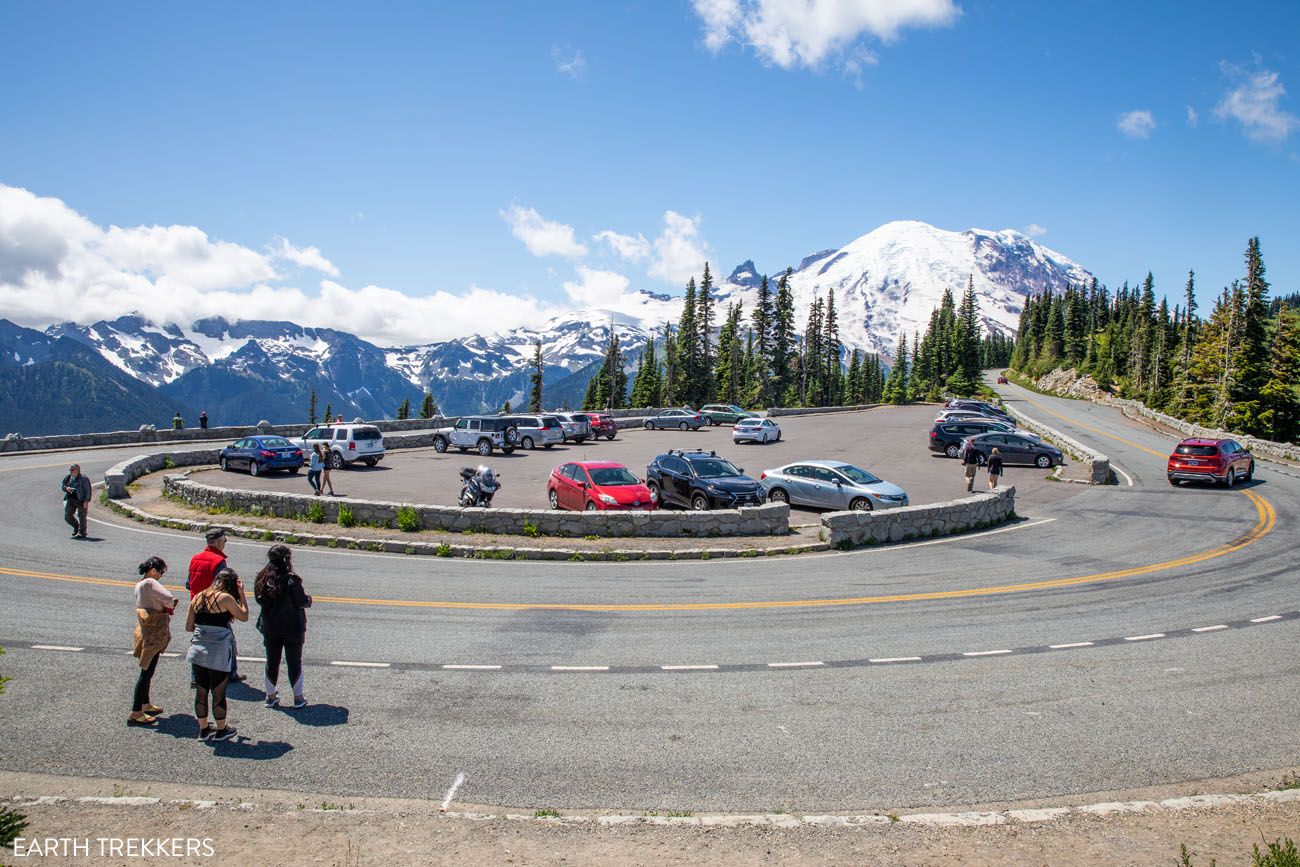
Sunrise Point
Take your pick from the list of trails that start in Sunrise. Some are short and sweet and others are much more strenuous.
I recommend hiking the Sourdough Ridge Trail…the views of Mount Rainier are awesome. For the best experience, continue out to the Mount Fremont Fire Lookout for truly spectacular views (6 miles round trip). The Sunrise Nature Trail is also nice hike if you are looking for something shorter.
For a detailed list of hikes in Sunrise, check out our article 15 Epic Day Hikes in Mount Rainier National Park.

Sourdough Ridge Trail
PRO TRAVEL TIP: Sunrise Road is only open during the summer. The road opens in late June or early July and closes in late September or early October.
Afternoon: Crystal Mountain
For one of the best views of Mount Rainier with very little effort, ride the Mount Rainier Gondola to Crystal Mountain.
From Crystal Mountain Resort, ride the gondola up to the peak of Crystal Mountain. This is the location of the Summit House Restaurant, Washington’s highest elevation restaurant.
The food is great and the view from the outdoor patio is absolutely amazing. There is also indoor seating if it is cold. Even during the summer months, temperatures can be very chilly, so bring extra layers for warmth.
For more details on hours and pricing, visit the official website.

Late Afternoon: Grove of the Patriarchs
As you drive south to Packwood, it’s worth hiking the Grove of the Patriarchs trail this afternoon, if you still have energy and if you can get a parking spot. Doing this now this frees up more time tomorrow.
This easy, 1.5 mile round-trip trail takes you past some of the largest and oldest trees in Mount Rainier National Park. These ancient Douglas firs, western red cedars, and western hemlocks are enormous. You will cross a suspension bridge and then walk on a series of boardwalk and dirt trails through the forest.
The Grove of the Patriarchs Trail is closed due to damage to the suspension bridge from flooding. Get updates on the National Park Service website.
Tonight, sleep in Packwood.
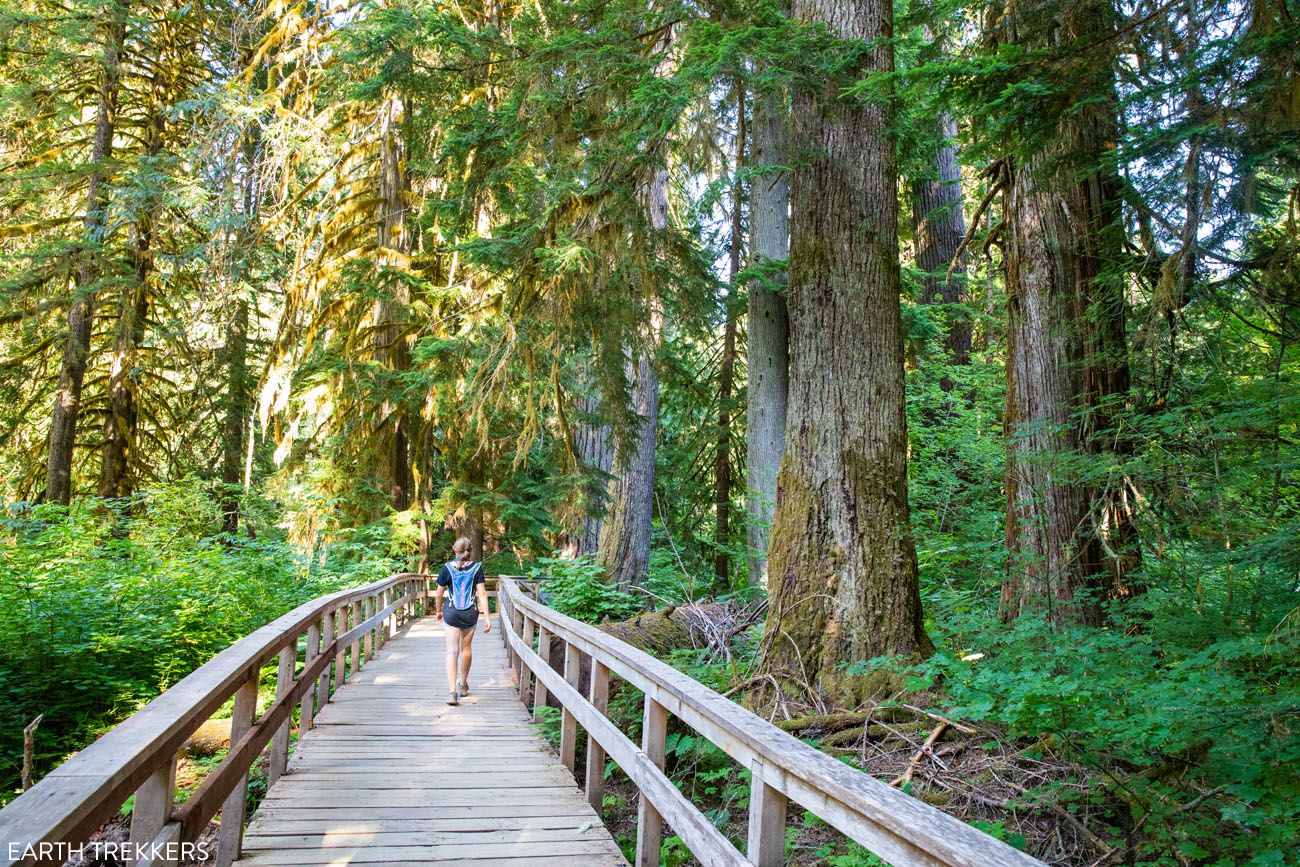
Grove of the Patriarchs
Day 2: Paradise
On the Road: 60 miles, 2 hours
Morning: Sights Along Stevens Canyon Road
If you didn’t walk the Grove of the Patriarchs trail yesterday (once it reopens), this is the perfect place to start your day.
After visiting the Grove of the Patriarchs, take Stevens Canyon Road west towards Paradise. On the drive, make the quick stop at Reflection Lake. You will also pass the trailhead for Snow and Bench Lakes, but I recommend skipping this hike, in order to give you more time in Paradise.

Reflection Lake
Late Morning & Midday: Paradise
Once in Paradise, take your pick from numerous hiking trails that lead higher onto Mount Rainier. The shorter, easier trails take you up to nice viewpoints of the mountain and these include the Alta Vista Trail (1.7 miles) and the Nisqually Vista Trail (1.2 miles). And don’t miss the short, easy walk to Myrtle Falls (1 mile, easy, 30 minutes).
For the best experience, hike the Skyline Trail to Panorama Point, one of the best hikes in Mount Rainier National Park. It’s a big day, 6.2 miles round trip with some hefty elevation gain, but you are rewarded with panoramic views of the park.
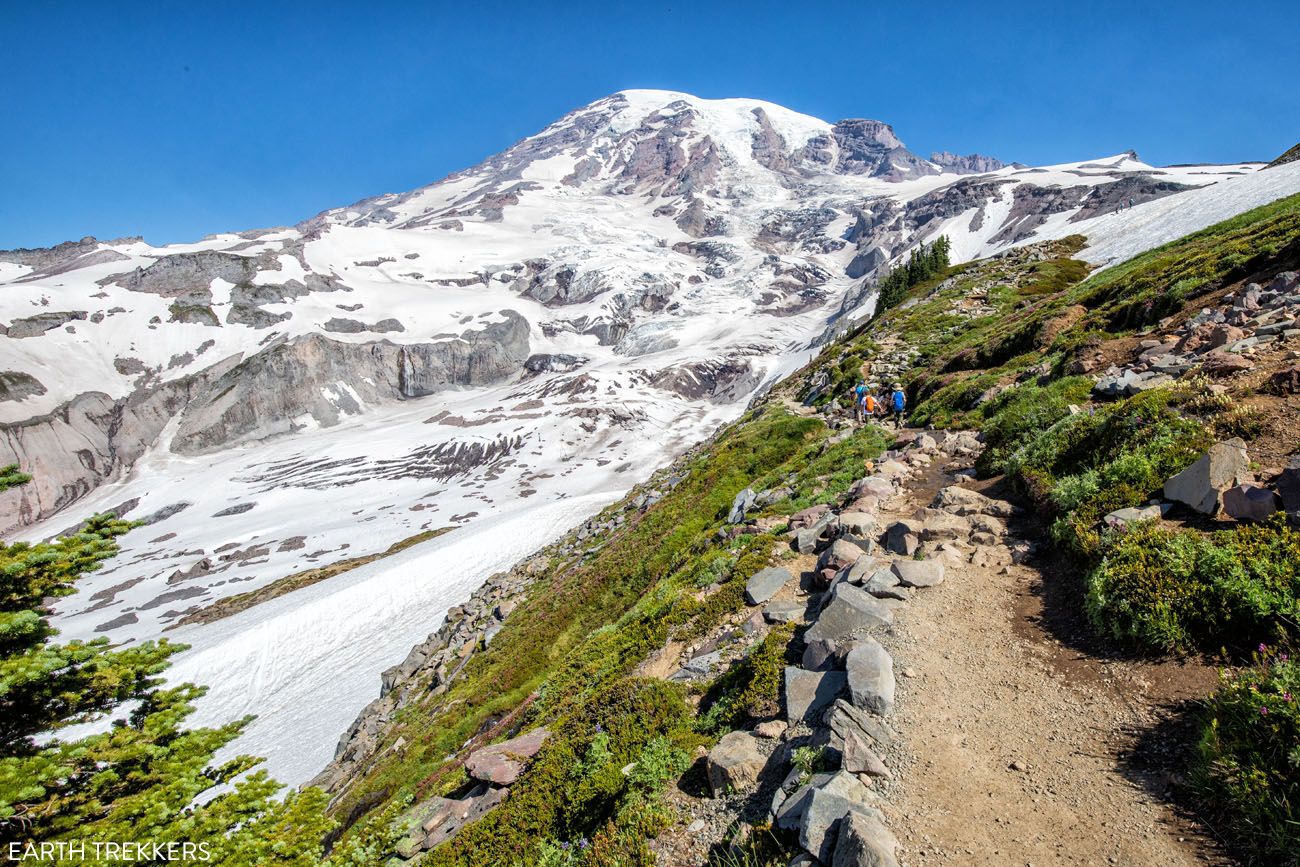
Skyline Trail
Afternoon
Once you are finished in Paradise, continue the drive west on Stevens Canyon Road. Optional stops along the drive are Narada Falls and Ricksecker Point.
With More Time
If you are an avid hiker, or if you just want to see more of the park, here are sample days to add onto your itinerary.
Hike the Summerland Trail to Panhandle Gap
This long, tough hike has a little bit of everything… old growth forests, fields of wildflowers, views of Mount Rainier, the chance to spot wildlife, high alpine views, and panoramic views out to Mount Adams.
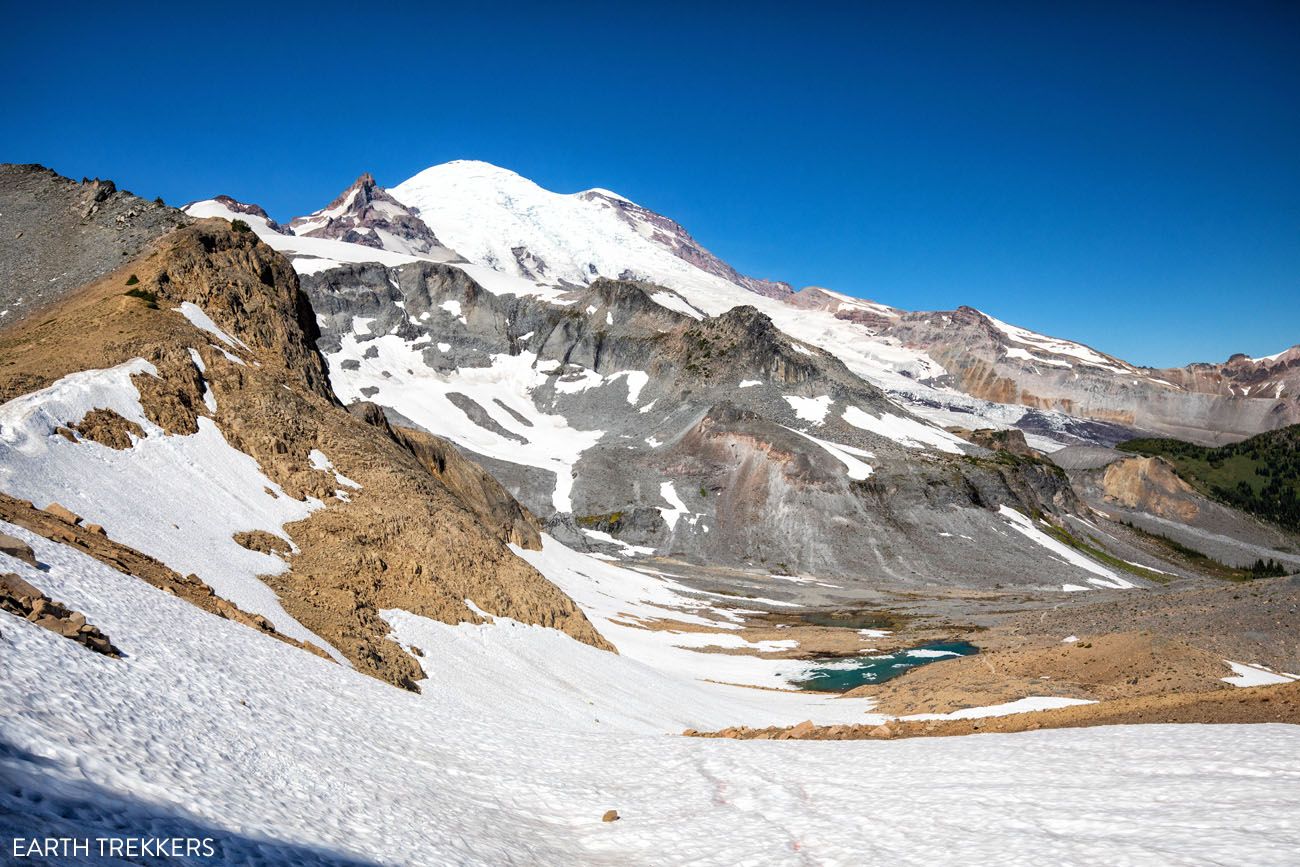
This hike is 12 miles long and takes 5 to 7 hours. It won’t take up a full day of your time, but most likely it will leave you feeling tired, so you could spend the rest of your day chilling at your hotel or campsite.
Summerland Trail to Panhandle Gap Hike | Mount Rainier National Park
Step-by-step trail guide for the Summerland Trail to Panhandle Gap.Go Hiking
If you don’t want to do a long hike like the Summerland Trail, there are plenty of shorter hikes to add onto this Mount Rainier National Park itinerary. Several short trails that we like and recommend are the Silver Falls Loop (3.4 miles, 2 hours, easy), Naches Peak Loop (3.6 miles, 2 hours, easy to moderate), and the Bench and Snow Lakes Trail (2.7 miles, 2 hours, moderate). You can also go on another hike in Sunrise, since so many hikes start here.
15 Epic Hikes in Mount Rainier National Park
Here are 15 hikes in Mount Rainier National Park, ranging from short, easy trails to longer, full day efforts.
Silver Falls
Summit Mount Rainier
If you want to do something truly epic that does not take up a lot of time, consider summiting Mount Rainier. This typically takes 2 days and most people do it with an experienced guide.
6 Day Mount Rainier National Park Itinerary
Here is our exact 6 day itinerary for Mount Rainier National Park. We visited Mount Rainier on a road trip through Washington. Just prior to our visit in Mount Rainier we were in Olympic National Park. From Mount Rainier, we traveled north to Leavenworth, the Enchantments, and North Cascades National Park.
Day 1: Morning: drive from Olympic National Park to Packwood. Midday an afternoon: Sunrise and the hike to Mount Fremont Lookout, Grove of the Patriarchs Trail. Sleep in Packwood.
Day 2: Hike to Sun Top Lookout (we found this hike to be boring and since we did this on a cloudy morning, we had zero visibility of Mount Rainier), Mount Rainier Gondola to Crystal Mountain, Silver Falls Loop Trail. Sleep in Packwood.
Day 3: Summerland Trail Hike. Sleep in Packwood.
Day 4: Naches Peak Loop hike. Bench and Snow Lakes hike. Reflection Lake. Paradise and the Nisqually Vista Trail. Narada Falls. Tim hiked the Skyline Trail in Paradise solo. Sleep in Ashford.
Day 5: Kara and I hiked the Skyline Trail together in the morning. Sleep in Ashford.
Day 6: Tolmie Peak Fire Lookout hike (this is currently inaccessible because of the Mowich Road closure). Sleep in Puyallup.
Tim had to work remotely on day 5, which is why he hiked the Skyline Trail solo on the evening of day 4 (he had a full time job outside of running this website). We also have some lighter days in this itinerary, since we need time to answer emails and comments on the website as we travel.

Skyline Trail
Practical Information
Park Hours: The park is open 24 hours a day, 365 days a year. Just be aware that large areas of the park will be closed due to road closures from winter weather.
Park Fee: $30 per vehicle, valid for 7 days. For a longer stay, purchase the Mount Rainier Annual Pass for $55 which gives you unlimited visits for one year.
If you plan to visit multiple national parks, purchase the America the Beautiful Pass ($80 and valid for all of the national parks for one year).
As you plan your trip and just before your visit, get updates on trail and road closures and park conditions on the National Park Service website.
If you have any questions about this Mount Rainier National Park itinerary, let us know in the comment section below.
If this is part of a bigger road trip through the USA, visit our United States Travel Guide and our Washington Travel Guide for more inspiration and travel planning tips.


















Comments 27